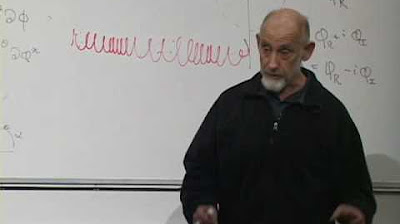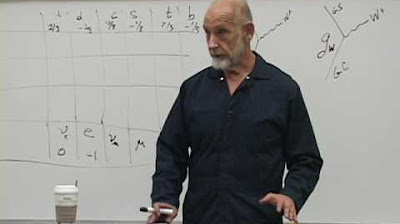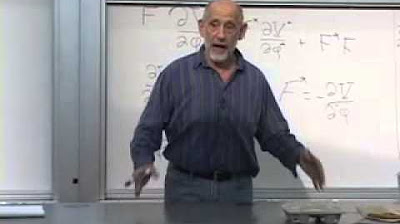Lecture 8 | New Revolutions in Particle Physics: Standard Model
TLDRThe transcript appears to be a lecture on the Higgs mechanism, a fundamental concept in particle physics that explains how particles acquire mass. The lecturer delves into the intricacies of gauge bosons, such as the photon, and how they can be given mass through spontaneous symmetry breaking. The concept of the Higgs field and its role in this process is explored, with the lecturer providing an analogy to superconductivity to illustrate the phenomenon. The lecture also touches on the conservation of electric charge and the symmetry associated with it, the mathematical representation of fields in physics, and the transformation properties of fields under gauge invariance. The lecturer promises to discuss the connection between the Higgs mechanism and the mass of fermions, such as electrons and quarks, in a subsequent session.
Takeaways
- 📚 The lecture discusses the concept of giving mass to the photon through spontaneous symmetry breaking, a phenomenon that also applies to the Z boson and W bosons.
- 🌟 The absence of mass in the photon might be an accident of nature due to the absence of an appropriate Higgs field, which is explored in the lecture.
- 🔬 In a superconductor, photons behave as if they have mass due to the breaking of symmetry, which is an example of the Higgs phenomenon.
- 🚫 The dispersion relation, which relates the frequency (Ω) and wave number (K), is key to understanding the propagation of waves and the concept of mass in particles.
- 🧲 The Goldstone boson is a massless particle resulting from the spontaneous symmetry breaking of a continuous symmetry, and it gets 'eaten' by the gauge boson, giving mass to the Higgs boson.
- ✨ The Higgs field is associated with the radial displacement of the field away from its equilibrium, and it is responsible for giving mass to particles.
- ⚙️ Gauge invariance is a fundamental symmetry in physics that prohibits the introduction of a mass term for the photon in the Lagrangian.
- 🎭 When the symmetry is spontaneously broken, the Goldstone boson disappears, and the photon appears to have mass, which is a key aspect of the Higgs mechanism.
- 🤔 The natural question arises as to why some particles gain mass through spontaneous symmetry breaking and others do not, with implications for understanding dark matter particles.
- ⚛️ The mathematics behind the Higgs mechanism involves complex fields and Lagrangians, and the transformation of these fields under symmetry breaking is crucial for mass generation.
- 🔗 The Higgs phenomenon is not only theoretical but also has practical applications, such as in the physics of superconductors, where charged bosons behave similarly to the described theoretical particles.
Q & A
What is the main topic of discussion in the provided transcript?
-The main topic of discussion is the phenomenon of giving mass to particles, specifically the concept of spontaneous symmetry breaking and how it relates to the Higgs field and gauge bosons like the photon.
What does the speaker mean when they refer to the 'Higgs field'?
-The Higgs field is a scalar field that permeates the universe, postulated in the Higgs mechanism, which gives mass to elementary particles through spontaneous symmetry breaking.
Why does the speaker say that the photon might have had a mass?
-The speaker suggests that the photon might have had a mass if there had been an appropriate Higgs field associated with it. The fact that it doesn't have a mass is possibly an accident of nature or due to the absence of such a field.
What is the role of the Z boson and W bosons in the context of the Higgs field?
-The Z boson and W bosons are examples of gauge bosons that acquire mass through the Higgs mechanism when the symmetry group associated with them is spontaneously broken.
How does the speaker explain the concept of a massless particle?
-The speaker explains that a massless particle is one where the energy (frequency) goes to zero as the wave number (momentum) goes to zero, which is typically represented by a linear dispersion relation.
What is the significance of the dispersion relation in the context of the discussion?
-The dispersion relation, which is the relationship between frequency (Ω) and wave number (K), is significant because it determines the propagation characteristics of waves. It indicates whether a wave is massless or massive based on its curvature at the origin.
What is the Goldstone boson and how is it related to the Higgs boson?
-The Goldstone boson is a massless particle that arises from the spontaneous symmetry breaking of a continuous symmetry. In the context of the Higgs mechanism, the Goldstone boson is 'eaten' by the gauge boson, which gives the Higgs boson its mass.
Why does the speaker mention superconductors in the context of the photon gaining mass?
-The speaker mentions superconductors as an example of a physical situation where photons behave as if they have mass when propagating through the medium, due to the breaking of gauge symmetry in the superconducting state.
What is the difference between a massive and a massless particle in terms of their dispersion relation?
-A massive particle has a dispersion relation that does not go to zero as the wave number goes to zero; it has a curvature, indicating a non-zero energy at zero momentum, which corresponds to the rest mass of the particle. A massless particle, on the other hand, has a linear dispersion relation where the energy goes to zero when the wave number is zero.
What does the speaker mean by 'spontaneous symmetry breaking'?
-Spontaneous symmetry breaking is a process in quantum field theory where a system, such as the Higgs field, goes into a state that does not exhibit the full symmetry of the underlying laws governing it. This breaking of symmetry is what gives particles their mass.
How does the speaker describe the relationship between the Higgs field and gauge invariance?
-The speaker describes that gauge invariance is a symmetry of the Lagrangian under which the phase of the field can be changed at every point in space. To maintain this symmetry, the concept of the covariant derivative is introduced, which includes the vector potential, leading to the mass of the gauge boson through the Higgs mechanism.
Outlines
📚 Introduction to Photon Mass and Symmetry Breaking
The speaker introduces the topic of the night: the concept of giving mass to the photon through spontaneous symmetry breaking. They clarify that photons don't actually acquire mass but delve into a theoretical scenario where the symmetry group associated with the photon is spontaneously broken, which would imply a mass for the photon. This discussion is tied to the real-world phenomena observed with Z and W bosons and the role of the Higgs field in providing mass to particles.
🌌 The Relationship Between Energy, Momentum, and Masslessness
The explanation of the relationship between energy, momentum, and the concept of masslessness is explored. The speaker describes the linear relationship between frequency (Ω) and wave number (K) for electromagnetic waves in a vacuum and contrasts it with the hyperbolic relationship for a particle with mass. They also touch on the behavior of light in a prism, the concept of dispersion relations, and how these tie into the idea of mass and its connection to the curvature of the potential energy of a field.
🌀 Entanglement, Fields, and the Concept of Mass
The speaker clarifies the misconception about entanglement and discusses the classical wave field. They explain the concept of the dispersion relation and its importance in understanding the behavior of waves with different velocities. The discussion then shifts to the Higgs boson, Goldstone bosons, and the phenomenon where the Goldstone boson 'gets eaten' by the gauge boson, endowing the Higgs boson with mass.
🧲 Gauge Bosons, Higgs Field, and the Standard Model
The focus is on gauge bosons and the role of the Higgs field in the context of the standard model of particle physics. The speaker explains that certain particles cannot have mass without spontaneous symmetry breaking. They discuss the intricacies of the Higgs field and its connection to the weak interactions' SU(2) symmetry, and how the gauge bosons receive mass through this process.
🤔 The Mathematics of Spontaneous Symmetry Breaking
The speaker outlines the mathematical framework behind spontaneous symmetry breaking, starting with a complex scalar field and its potential energy. They describe how the field can be represented in terms of radial and angular components, and how the Lagrangian for the field is constructed. The potential energy's role in determining the mass of the field's excitations is also explained.
🔗 The Higgs Mechanism and Gauge Invariance
The discussion moves to the Higgs mechanism and its connection to gauge invariance. The speaker explains how the gauge symmetry prohibits the photon from having mass and how the introduction of a vector potential and the concept of a covariant derivative maintain this symmetry. The electromagnetic part of the Lagrangian and its gauge invariance are also covered, setting the stage for the Higgs field's role in providing mass to particles.
🌟 The Higgs Field and Spontaneous Symmetry Breaking
The speaker delves into the Higgs field's role in spontaneous symmetry breaking. They describe how the Higgs field's non-zero vacuum expectation value leads to the phenomenon where the Goldstone boson disappears, and the photon appears to acquire mass in a symmetrically broken state. The summary also touches on the physics of superconductors and the parallels with the Higgs mechanism.
🚀 Photon Polarization and the Higgs Phenomenon
The final paragraph discusses the nature of the photon as a massless particle with two polarization states and how the concept of gauge invariance prevents the photon from having a mass term in the Lagrangian. The speaker also explains that the Goldstone boson effectively becomes the longitudinal polarization of the photon, maintaining the total degrees of freedom in the system and hinting at the next topic: how fermions like electrons and quarks get their mass from the Higgs phenomenon.
Mindmap
Keywords
💡Spontaneous Symmetry Breaking
💡Higgs Field
💡Gauge Bosons
💡Goldstone Bosons
💡Photon
💡Superconductivity
💡Cooper Pairs
💡Vector Potential
💡Lagrangian
💡Complex Scalar Field
💡Gauge Invariance
Highlights
The lecture discusses the phenomenon of giving mass to the photon through spontaneous symmetry breaking, which is a fundamental concept in particle physics.
The Higgs field is introduced as a means to give mass to gauge bosons like the photon, which is typically massless.
The absence of a photon's mass is suggested to be an accident of nature, potentially due to the absence of an appropriate Higgs field.
The Z boson and W bosons are highlighted as examples where spontaneous symmetry breaking occurs, giving them mass.
The concept of a conserved quantity, such as electric charge, and its connection to symmetries is explained.
Superconductors are mentioned as a natural occurrence where photons behave as if they have mass, demonstrating the Higgs phenomenon.
The difference between group velocity and the speed of light in a medium, such as a prism, is clarified.
The dispersion relation, which relates frequency to wave number, is introduced as a key concept in understanding wave behavior.
The conditions under which a wave is considered massless are explored, particularly when its frequency approaches zero as the wave number approaches zero.
The mathematical representation of a particle with mass is contrasted with that of a massless particle, highlighting the role of the potential energy curve.
The Goldstone boson is introduced as a massless particle resulting from spontaneous symmetry breaking.
The phenomenon of the Goldstone boson being 'eaten' by the gauge boson, resulting in a massive Higgs boson, is described.
The mathematics behind spontaneous symmetry breaking in the context of the standard model of particle physics is outlined.
The distinction between particles that acquire mass through spontaneous symmetry breaking and those that do not is discussed, with speculation on why we observe the former.
The potential existence of additional particles in nature, such as dark matter particles, is mentioned with a discussion on their mass.
The lecture concludes with a teaser for the next topic: how fermions and quarks get their mass from the Higgs phenomenon.
Transcripts
Browse More Related Video

Lecture 9 | New Revolutions in Particle Physics: Standard Model

Lecture 7 | New Revolutions in Particle Physics: Standard Model

Lecture 6 | New Revolutions in Particle Physics: Standard Model

Lecture 10 | New Revolutions in Particle Physics: Standard Model

Special Relativity | Lecture 5

Supersymmetry & Grand Unification: Lecture 9
5.0 / 5 (0 votes)
Thanks for rating: